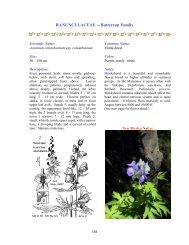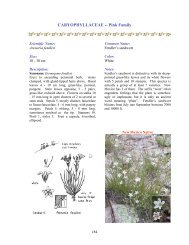BERBERIDACEAE -- Barberry Family - New Mexico Flores
BERBERIDACEAE -- Barberry Family - New Mexico Flores
BERBERIDACEAE -- Barberry Family - New Mexico Flores
You also want an ePaper? Increase the reach of your titles
YUMPU automatically turns print PDFs into web optimized ePapers that Google loves.
Scientific Name:<br />
Camelina microcarpa<br />
Size:<br />
30 - 80 cm<br />
BRASSICACEAE -- Mustard <strong>Family</strong><br />
Description:<br />
Erect annual herb, stems branched above.<br />
Herbage rough-hairy, with simple and branched<br />
or star-shaped hairs. Leaves alternate,<br />
triangular-lanceolate, sessile, with smooth<br />
edges, the leaf bases wrapped around stem.<br />
Flowers perfect, on glabrous upward curving<br />
stalks 8 - 18 mm long, in loose clusters at<br />
branch ends, greatly elongating in fruit. Sepals<br />
4, erect, hairy, deciduous, 2 - 3 mm long. Petals<br />
4, spatulate, 3 - 4 mm long, rounded at the apex.<br />
Stamens 6, 4 equal, 2 shorter. Fruit a glabrous<br />
obovoid pod 5 - 7 mm long, 3 - 4 mm in<br />
diameter, divided into 2 compartments by a<br />
membrane. Style persistent, about half as long<br />
as pod.<br />
145<br />
Common Name:<br />
Smallseed falseflax<br />
Color:<br />
White to yellow<br />
Notes:<br />
With its narrow, alternate leaves and stalked<br />
fruits scattered along the upper stems, falseflax<br />
resembles true flax, Linum usitatissimum. Both<br />
are native to Eurasia, imported to the United<br />
States by European colonists. The genus name<br />
Camelina is derived from two Greek roots,<br />
chamae, “lowly” or “creeping” and linon,<br />
“flax”, in reference to the common presence of<br />
Camelina in cultivated flax fields. C.<br />
microcarpa blooms from May through June<br />
between 4500 and 7500 ft.<br />
Introduced*




